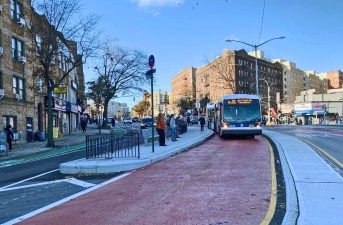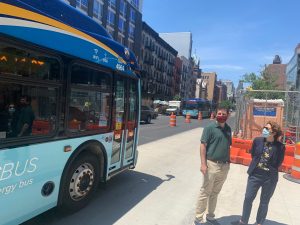MTA and DOT Make Bus Service Announcement that is Both Underwhelming and Exciting!

This glass is definitely half full!
MTA and city Department of Transportation officials announced on Monday that they will improve bus service for hundreds of thousands of New Yorkers — improvements that have been stalled until the resignation of Gov. Cuomo and otherwise put off until the final one-24th of Mayor de Blasio’s tenure.
The announcement includes many improvements that have been underway for years, including:
- more cameras to enforce bus lanes. The goal is cover up to 85 percent of existing bus lanes by the end of 2023, but that will require the installation of 900 more on-bus cameras, up from 100 today.
- 20 miles of new or improved dedicated bus lanes or busways to be built in 2022, including five car-free busways (the city is required to do 30 miles of bus lanes per year, starting in 2022).
- 750 more intersections that give buses the green light, a system known as transit signal priority. So far this year, the DOT has installed such systems at more than 300 intersections.
- a commitment to actually finish already-begun bus network redesigns in Queens and The Bronx — and begin one in Brooklyn. (The Bronx redesign was virtually complete when the pandemic struck, and is now looking at a June, 2022 launch, according to New York City Transit President Craig Cipriano.)
- A pilot program to bring all-door boarding … to 10 local lines.
Advocates were quick to praise the laundry list of improvements, though when pressed by Streetsblog, were just as quick to admit that they wish there had been more.
“The good news is that there is movement and there really hasn’t been movement before,” said TransitCenter spokesman Ben Fried. “These are not brand new ideas, but they are ideas that have stalled, so it’s a really good thing they’re moving again.”
Jaqi Cohen of the Straphangers Campaign took a similar tack.
“This is not ‘Mission accomplished,’ but it is good that MTA and DOT are working together on good stuff,” she said. “We need all the collaboration possible, especially with all the uncertainty at both levels of government.”
Ah, yes, transition in government — it was impossible to avoid seeing Monday’s announcement as at least a new day for the MTA and DOT’s relationship with the second floor of the State Capitol. Bus network redesign, for example, was a major initiative put forward by then-New York City Transit President Andy Byford … before Gov. Cuomo ran him out of town on a rail. Similarly, all-door boarding was not pushed by the governor, who was more interested in drawing attention to fare evasion than making it easier for bus riders to board, advocates said.
“I see a linkage between Monday’s announcement and the political turnover in Albany,” Fried said, citing the redesigns as evidence that the MTA is willing to act because “Cuomo’s grip on power is relaxed.”
“It’s not a totally brand new day at the MTA, but there’s an element of glasnost and perestroika to this announcement,” he said. “To do bus redesigns right, you need gubernatorial support. And it’s a good sign that this is a joint MTA/DOT announcement because they have to coordinate a lot of things and it’s more likely to happen when the governor does not hold a permanent grudge against the mayor.”
“The glass is half full, so keep pouring,” added Danny Pearlstein of Riders Alliance upon hearing the lede of this story. “That said, we are very encouraged by the partnership between MTA and DOT. Clearly, the logjam has been broken. The toxic relationship between Andrew Cuomo and Bill de Blasio no longer matters.”
Pearlstein said he was excited that MTA CEO Janno Lieber and DOT Commissioner Hank Gutman appeared at the same press conference, a symbol of two agencies working together.
“We saw a glimmer of that back when Polly Trottenberg and Andy Byford would appear together — and that partnership led to the greatest thing since sliced bread: the 14th Street busway,” Pearlstein added.

Both Fried and Cohen pointed out that the all-door-boarding pilot — which will start with just 10 still-unspecified lines in hopes of having all-door-boarding available on every bus by the end of 2023 — was not ambitious enough.
“They should do it on a bigger scale,” Fried said.
The pilot, Cohen added, “is a start.”
Cohen’s group had mocked the MTA earlier this summer with an “All-Door Boarding Bingo” card to show how straphangers will constantly be late for work until the agency made good on its promise (play along, right). In 2020, the MTA finished installing OMNY readers on all buses in preparation for a 2021 implementation date that would never come.
Cipriano said the MTA needed an all-door boarding pilot because “we want to gather information.”
“We want to know that those who are using cash and still have the opportunity to use that at the front door, we want to see how that speeds up our buses,” he said, of a program that the MTA has already said speeds up buses. “We want to take a look at some routes with narrow spacing, with wide spacing. Maybe the value is so great that we accelerate that commitment.”
Regarding the city’s portion of the announcement, the news was far from overwhelming. The 20 miles of new or improved dedicated bus lanes is 10 miles fewer than the city is required to build under the Streets Master Plan that the DOT must turn in by the end of the year.
That said, those 20 miles of bus improvements include five more short car-free busways, to join the three short stretches of busways — along Jay Street in Brooklyn, Main Street in Flushing and 181st Street in Washington Heights — that the city has installed since mid-2020 after the initial success of the 14th Street busway.
The locations of the new busways were not revealed. It is unclear if the “new” busways will include a pair of bus-only projects that the city says it is working on in Jamaica; after local officials opposed a car-free busway on Jamaica Avenue in favor of one on Archer Avenue, the city united the two plans into one double-busway project.
Streetsblog asked DOT Commissioner Hank Gutman why busways and dedicated bus lanes take so long to install, and here’s what he said.
We’ve learned that every time we propose one of these, there will almost always be someone in the community who doesn’t like the idea. … So an important part of it and something that explains some of the delay is that we have to go through a process, we have to hear people respectfully we have to consider their concerns and their objections and then trying to, in the end, do what’s right for the people of that community and the people in the city. And sometimes that takes time, but it’s time well spent because it’s respecting the views of New Yorkers. Our experience shows is that they are dramatically successful when we put them in [after community consultation] so it’s worth the time and it’s worth the effort. It’s worth the contention and it’s sometimes worth the fight, because looking back on them, they’ve all been successful and end up often being more popular in the community then one might have thought based on the initial reaction.
The busways that the city has created since 14th Street have all been very short segments, mostly the most congested places where many bus lines converge, such as in Downtown Brooklyn or Flushing. Left unannounced on Monday was any plan to dramatically reduce car traffic and car storage so that buses could have roadways entirely to themselves and are not constantly stuck in congestion or behind double-parked vehicles.
Pearlstein saw the glass as half-empty there.
“The number of bus lanes is not enough,” he said. “Transit simply needs priority on every busy street in New York City. Private car traffic has to take a back seat.”
He cited Streetsblog’s coverage on Monday of the MTA’s ongoing service reductions on its M21 bus in Soho to accommodate drivers over bus passengers.
“What they do on M21 is outrageous and utterly emblematic of a transit system that prioritizes cars over transit users,” he said.
— with Dave Colon




